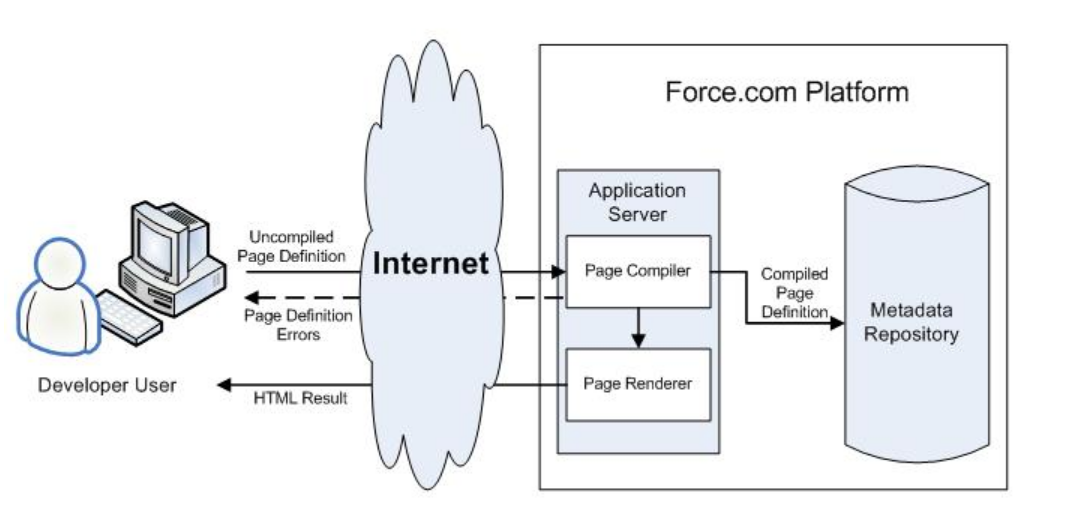Introduction to Visual Force
Introduction to Visualforce
The Visualforce platform lays down the framework for developing on-demand applications on the Salesforce platform. Each of the components created on Visualforce has got a specific data model on which the data is structured. It has business logic, which defines data manipulation. It also defines the layout on which the user interface is based. From the perspective of application development, this kind of application development is termed as MVC (Model View Control). Here, the model is the data model, the view is the user interface, and control is the business logic.
The Visualforce platform makes use of tag-based markup language. It is equivalent to HTML. It is made up of server-side "standard controllers" that ultimately creates essential database activities. In Visualforce, the markup language has got Visualforce tag, each of these Visualforce tags compares to a specific or definite user interface segment. This could be an area of a page. It could be a related rundown. It could be a field as well. The behavior of the Visualforce parts can be directly limited by a similar kind of limitations that exist on the standard Salesforce pages. Developers can connect their use case with a controller class that might be written in Apex.
Visualforce Markup
Visualforce Markup is made up of certain components. This includes Visualforce labels, HTML, JavaScript, or along with certain Web-empowered code that is inserted within a solitary <apex: page> tag. Visual Markup develops the UI parts that are supposed to be there on the page. It also determines how they are supposed to show up on the page.
Visualforce Controller
A Visualforce controller can be described as a framework that indicates what happens when a user interacts with the parts marked in related Visualforce markup. A good example is when a user clicks a particular catch or a connection. Controllers also give access to the information that is supposed to be displayed on a page and is capable of changing the behavior.
A developer can use the standard controller available on the lightning framework. He also has the option of using a custom controller for developing Visualforce components. Here, a standard controller has a similar kind of functionality that a standard Salesforce page has. For example, if you are utilizing the standard Accounts controller, you can click on the Save button on a Visualforce page. The behavior of the page will be the same as the Standard account page on the Salesforce when the save button is clicked.
Architecture of Visualforce
Visualforce is completely based on the lightning platform. This is well depicted in the picture shown below.

This can be sequenced as mentioned below:
- Developer finishes coding a Visualforce page
- He saves it on the platform.
- The platform application server attempts to compile or convert the markup into an abstract set of instructions.
- This abstract set of instructions should be understood by the Visualforce renderer. If the compilation generates errors, it is not saved, followed by the return of errors to the developer.
- If there are no errors, the instructions are saved to the metadata repository and sent to the Visualforce renderer.
- The renderer then converts the instructions into HTML.
- Then the renderer refreshes the developer's view, it provides instant feedback to the developer regarding the changes that were made in the markup.
Benefits of Visualforce
There are multiple benefits of Visualforce, and that is the reason it is preferred by the developers. Some of these benefits are listed below.
- It provides a user-friendly environment for the development of on-demand applications for Salesforce. Developers can edit the code, as well as compile & view the result in the same window. This saves time and makes development hassle-free.
- It integrates well with other web-based technologies. It integrates perfectly with HTML, Javascript, and even Flash. Developers can extend these technologies into their components.
- It follows an MVC or model view container pattern of development. MVC model demarcates the data, UI, and business logic. Everything is independent. This provides much-needed flexibility to the developers.
- The syntax and tagging in Visual force are extremely simple. If one has already used markup languages such as HTML or XML, they can develop Visualforce components at ease, with minimal training.

